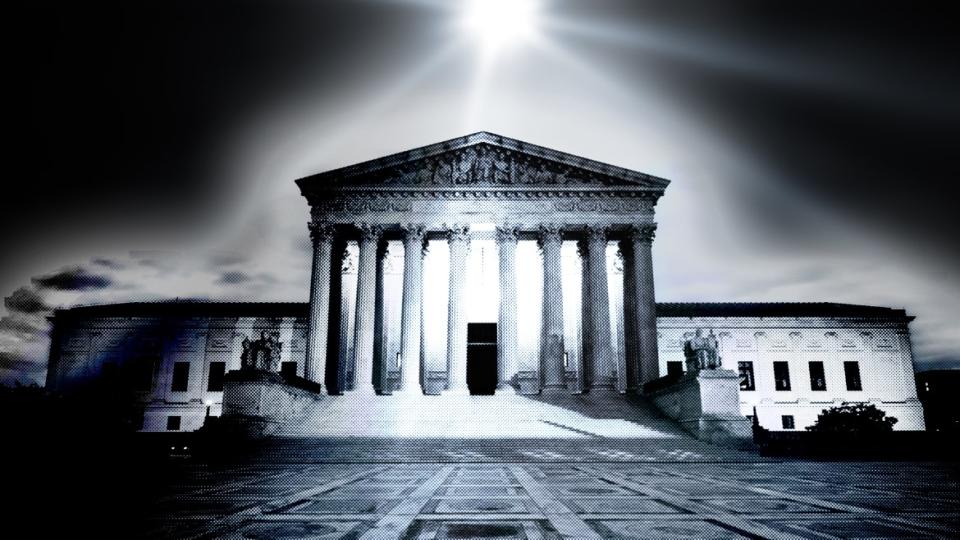How the Christian Right Took Over the Supreme Court

There are Supreme Court commentators, and then there’s Linda Greenhouse.
No one else has Greenhouse’s talent for explaining the significance of the court’s decisions, not to mention her access to seemingly everyone in Washington, D.C., and her sheer talent as a writer. For decades, she has been a familiar face at Supreme Court arguments—think Anna Wintour at Fashion Week or Spike Lee at Knicks games—writing over 2,800 articles for The New York Times and lately writing and lecturing at Yale Law School.
Now, Greenhouse has turned her attention to the slow-motion revolution underway at the Supreme Court, in a new book entitled Justice on the Brink . As the book shows in occasionally excruciating detail, we are living in an unprecedented moment for the court: Three hard-right justices, each handpicked by religious extremists and confirmed under clouds of illegitimacy, are part of a 6-3 conservative majority “on the brink,” as Greenhouse’s title suggests, of radically transforming the way our republic regards civil rights, the equal protection of the laws, and the nature of our democracy itself.
In part, Justice on the Brink argues that this transformation has already taken place with the appointment of Justice Amy Coney Barrett, rushed onto the court after the 2020 presidential election had already begun. Some of my fellow Supreme Court commentators have agreed, arguing that the court now effectively belongs to Barrett.
The Secrets of Leonard Leo, the Man Behind Trump’s Supreme Court Pick
But this seems premature. Though there have been some rumblings of change, as Greenhouse describes, surely we are still on the brink—not there yet. Far more sweeping changes are coming this term, with the court poised to overturn or limit Roe v. Wade, greatly expand the reach of the Second Amendment, and shrink the reach of the administrative state.
In fact, in Greenhouse’s presentation of the “twelve months that transformed the Supreme Court,” one is struck by how much the court was not transformed. It survived perhaps the greatest threat to its legitimacy: Donald Trump’s outrageous efforts to undo the 2020 election. There was no 2020 version of Bush v. Gore, which handed the election to Bush, contradicted decades of Supreme Court precedent (in particular regarding deference to state courts), and permanently tarnished the court’s reputation. In fact, the Supreme Court swatted away Trump’s frivolous lawsuits, much to the ire of the ex-president, whose outrage Greenhouse reports verbatim. “We got him through,” Trump said of Justice Brett Kavanaugh on Jan. 6, while inciting an insurrection against Congress. “And you know what? They couldn’t give a damn… They’re all going out of their way to hurt all of us, and to hurt our country.”
Not only did the court “fail” to cave to Trump, the already-transformed Supreme Court voted 6-3 to dismiss a partisan challenge to the Affordable Care Act for lack of standing, and 6-3 to exempt a Catholic foster care agency from civil rights laws on narrow grounds, rather than on the broad, far-reaching basis that Christian Right organizations had demanded. Both of those results were judicially conservative, but with results that favored (or at least didn’t trash) liberal interests.
Indeed, Greenhouse states plainly regarding the foster care case, “the winner in Fulton was Roberts.” This was not a court that had been transformed; it was a court that showed surprising resilience in the face of enormous pressure.
True, on the last day of the term, the court announced two hard-right decisions on voting rights (anti) and dark money (pro). But those would have gone the same way before the Ginsburg-Barrett switch, and Chief Justice John Roberts, whom Greenhouse depicts as a pragmatist moderate, has in fact been eviscerating voting rights for decades.
Rather than focus on these high-profile decisions, Greenhouse spends a great deal of time on minor cases—death penalty appeals, various administrative law decisions, an expansion of the rights of religious schools—that, she says, show a steady drip-drip-drip rightward. Perhaps, but here Justice on the Brink reads like too much Greenhouse the court observer and too little Greenhouse the social commentator. Even for a Supreme Court nerd, these smaller matters seem like too many trees, too little forest.

 Yahoo Autos
Yahoo Autos 